Article | TRANSPORTATION,ABSTRACT
VerifiedAdded on 2022/08/12
|9
|2351
|41
AI Summary
Contribute Materials
Your contribution can guide someone’s learning journey. Share your
documents today.
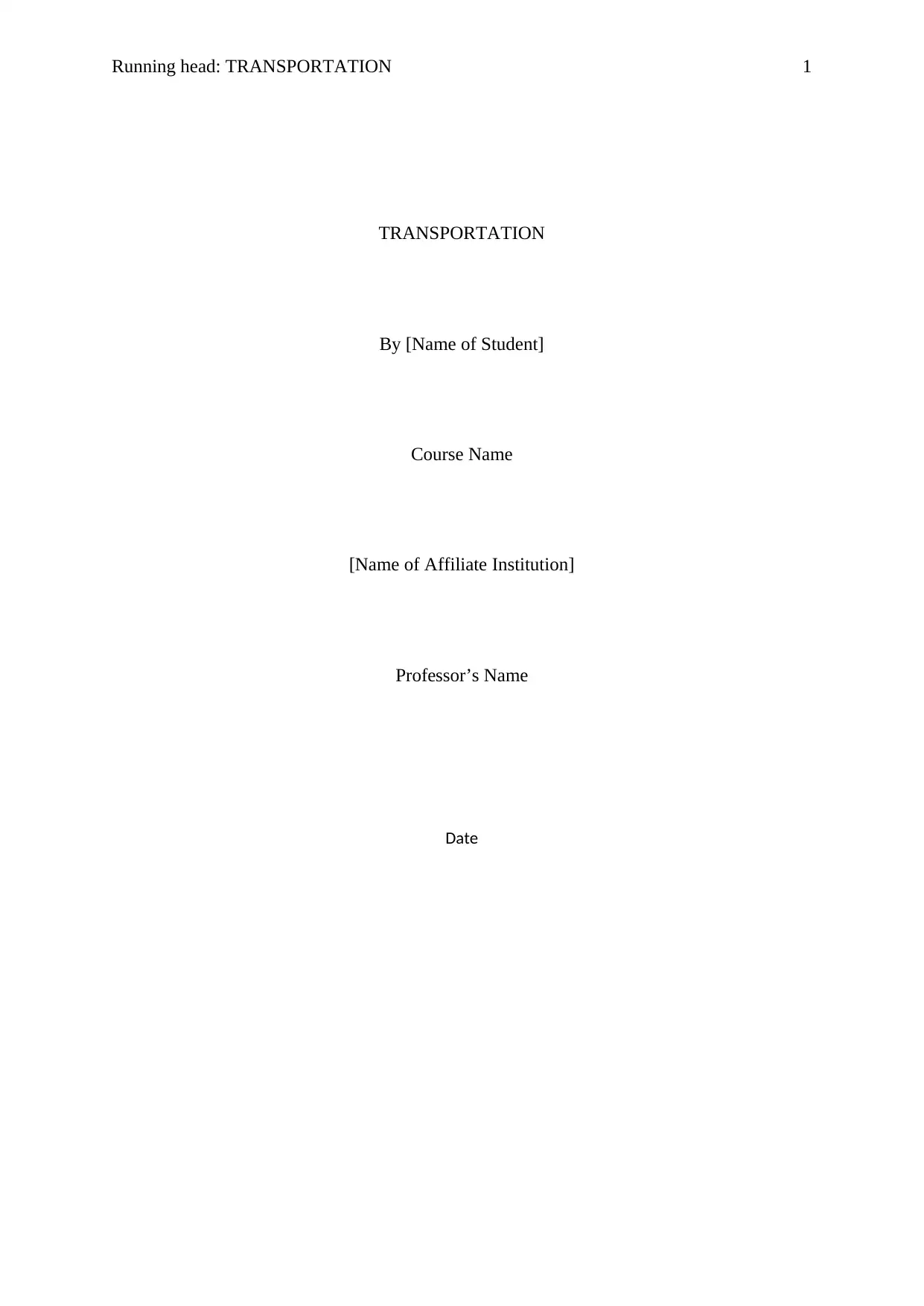
Running head: TRANSPORTATION 1
TRANSPORTATION
By [Name of Student]
Course Name
[Name of Affiliate Institution]
Professor’s Name
Date
TRANSPORTATION
By [Name of Student]
Course Name
[Name of Affiliate Institution]
Professor’s Name
Date
Secure Best Marks with AI Grader
Need help grading? Try our AI Grader for instant feedback on your assignments.
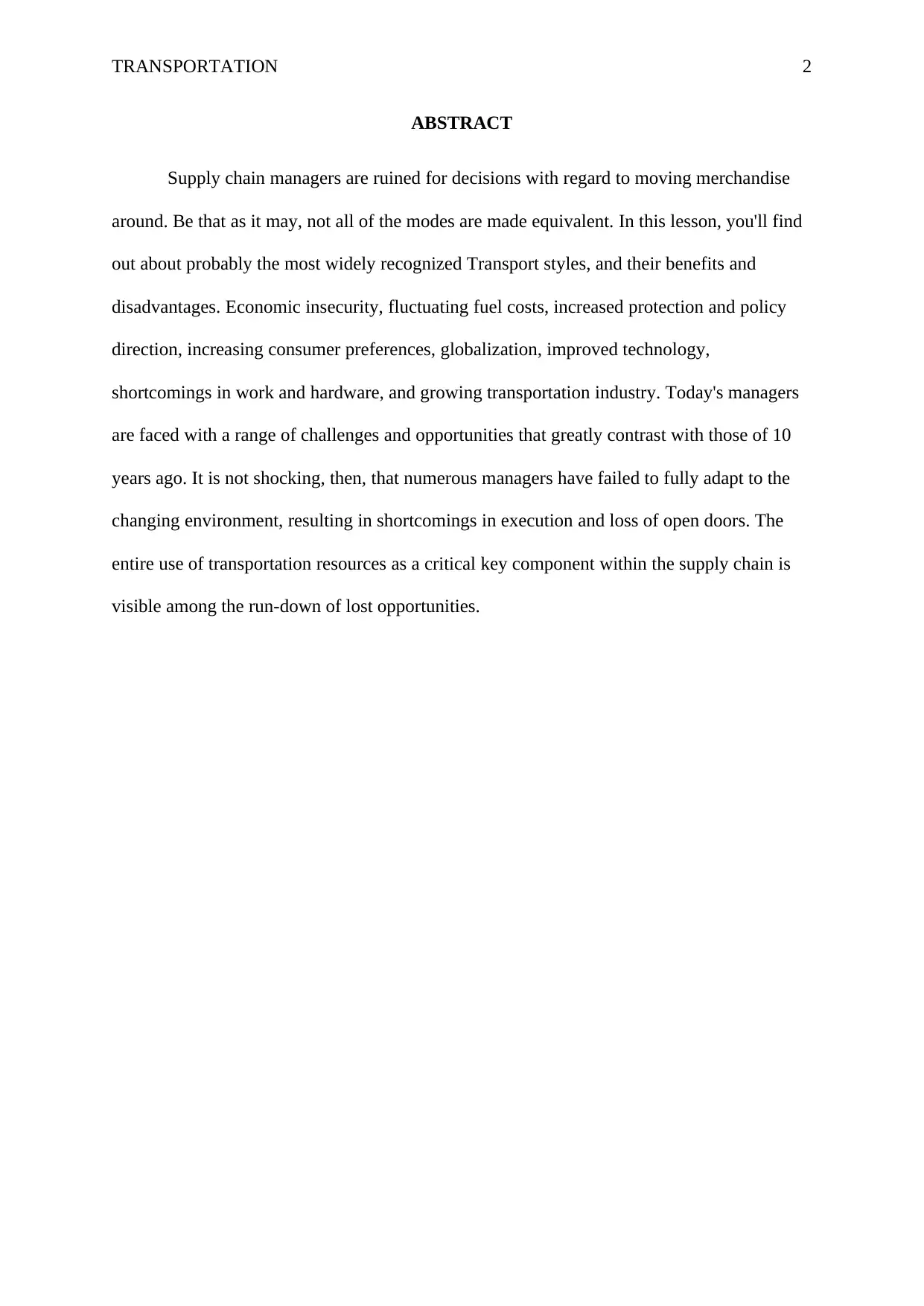
TRANSPORTATION 2
ABSTRACT
Supply chain managers are ruined for decisions with regard to moving merchandise
around. Be that as it may, not all of the modes are made equivalent. In this lesson, you'll find
out about probably the most widely recognized Transport styles, and their benefits and
disadvantages. Economic insecurity, fluctuating fuel costs, increased protection and policy
direction, increasing consumer preferences, globalization, improved technology,
shortcomings in work and hardware, and growing transportation industry. Today's managers
are faced with a range of challenges and opportunities that greatly contrast with those of 10
years ago. It is not shocking, then, that numerous managers have failed to fully adapt to the
changing environment, resulting in shortcomings in execution and loss of open doors. The
entire use of transportation resources as a critical key component within the supply chain is
visible among the run-down of lost opportunities.
ABSTRACT
Supply chain managers are ruined for decisions with regard to moving merchandise
around. Be that as it may, not all of the modes are made equivalent. In this lesson, you'll find
out about probably the most widely recognized Transport styles, and their benefits and
disadvantages. Economic insecurity, fluctuating fuel costs, increased protection and policy
direction, increasing consumer preferences, globalization, improved technology,
shortcomings in work and hardware, and growing transportation industry. Today's managers
are faced with a range of challenges and opportunities that greatly contrast with those of 10
years ago. It is not shocking, then, that numerous managers have failed to fully adapt to the
changing environment, resulting in shortcomings in execution and loss of open doors. The
entire use of transportation resources as a critical key component within the supply chain is
visible among the run-down of lost opportunities.
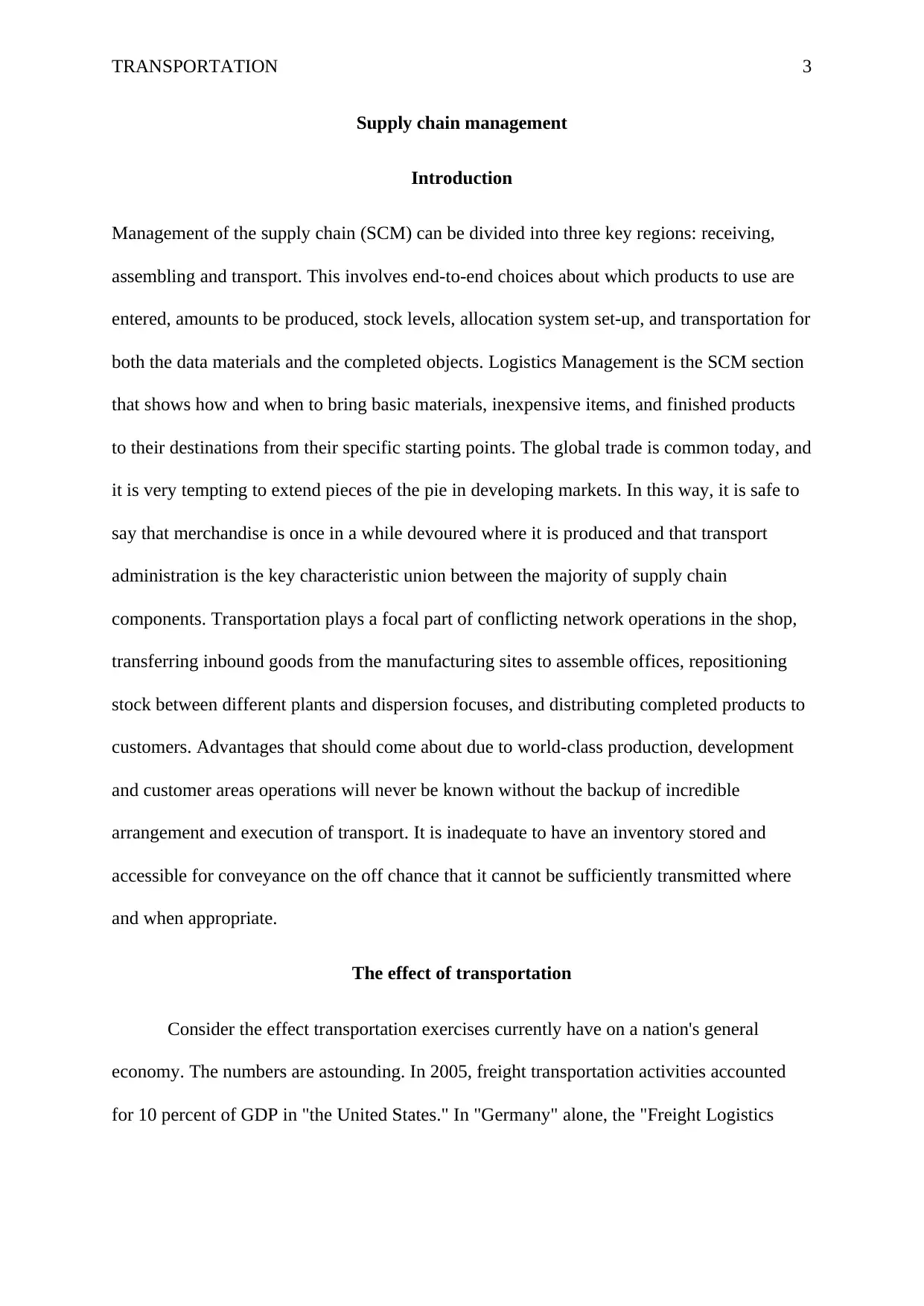
TRANSPORTATION 3
Supply chain management
Introduction
Management of the supply chain (SCM) can be divided into three key regions: receiving,
assembling and transport. This involves end-to-end choices about which products to use are
entered, amounts to be produced, stock levels, allocation system set-up, and transportation for
both the data materials and the completed objects. Logistics Management is the SCM section
that shows how and when to bring basic materials, inexpensive items, and finished products
to their destinations from their specific starting points. The global trade is common today, and
it is very tempting to extend pieces of the pie in developing markets. In this way, it is safe to
say that merchandise is once in a while devoured where it is produced and that transport
administration is the key characteristic union between the majority of supply chain
components. Transportation plays a focal part of conflicting network operations in the shop,
transferring inbound goods from the manufacturing sites to assemble offices, repositioning
stock between different plants and dispersion focuses, and distributing completed products to
customers. Advantages that should come about due to world-class production, development
and customer areas operations will never be known without the backup of incredible
arrangement and execution of transport. It is inadequate to have an inventory stored and
accessible for conveyance on the off chance that it cannot be sufficiently transmitted where
and when appropriate.
The effect of transportation
Consider the effect transportation exercises currently have on a nation's general
economy. The numbers are astounding. In 2005, freight transportation activities accounted
for 10 percent of GDP in "the United States." In "Germany" alone, the "Freight Logistics
Supply chain management
Introduction
Management of the supply chain (SCM) can be divided into three key regions: receiving,
assembling and transport. This involves end-to-end choices about which products to use are
entered, amounts to be produced, stock levels, allocation system set-up, and transportation for
both the data materials and the completed objects. Logistics Management is the SCM section
that shows how and when to bring basic materials, inexpensive items, and finished products
to their destinations from their specific starting points. The global trade is common today, and
it is very tempting to extend pieces of the pie in developing markets. In this way, it is safe to
say that merchandise is once in a while devoured where it is produced and that transport
administration is the key characteristic union between the majority of supply chain
components. Transportation plays a focal part of conflicting network operations in the shop,
transferring inbound goods from the manufacturing sites to assemble offices, repositioning
stock between different plants and dispersion focuses, and distributing completed products to
customers. Advantages that should come about due to world-class production, development
and customer areas operations will never be known without the backup of incredible
arrangement and execution of transport. It is inadequate to have an inventory stored and
accessible for conveyance on the off chance that it cannot be sufficiently transmitted where
and when appropriate.
The effect of transportation
Consider the effect transportation exercises currently have on a nation's general
economy. The numbers are astounding. In 2005, freight transportation activities accounted
for 10 percent of GDP in "the United States." In "Germany" alone, the "Freight Logistics
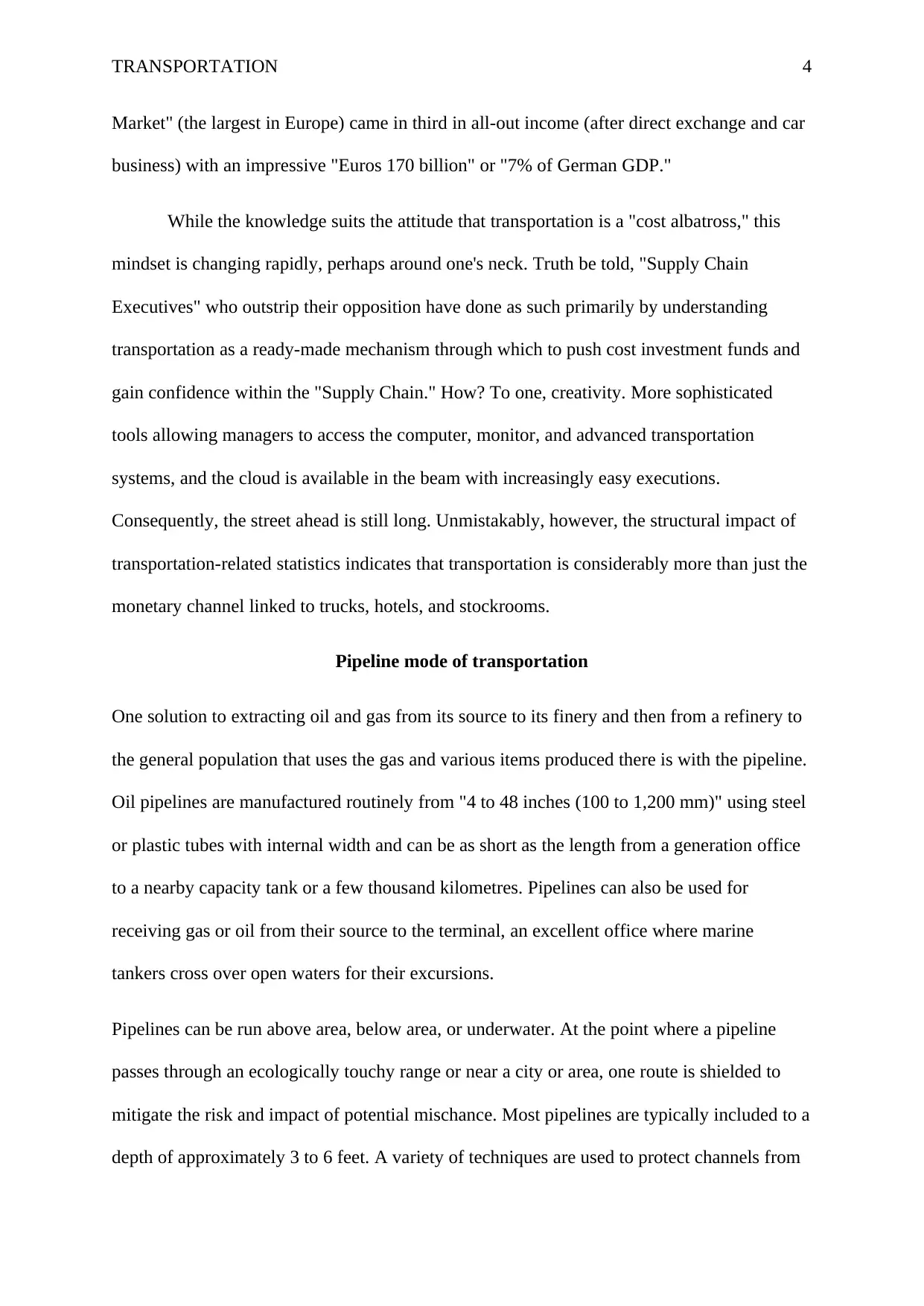
TRANSPORTATION 4
Market" (the largest in Europe) came in third in all-out income (after direct exchange and car
business) with an impressive "Euros 170 billion" or "7% of German GDP."
While the knowledge suits the attitude that transportation is a "cost albatross," this
mindset is changing rapidly, perhaps around one's neck. Truth be told, "Supply Chain
Executives" who outstrip their opposition have done as such primarily by understanding
transportation as a ready-made mechanism through which to push cost investment funds and
gain confidence within the "Supply Chain." How? To one, creativity. More sophisticated
tools allowing managers to access the computer, monitor, and advanced transportation
systems, and the cloud is available in the beam with increasingly easy executions.
Consequently, the street ahead is still long. Unmistakably, however, the structural impact of
transportation-related statistics indicates that transportation is considerably more than just the
monetary channel linked to trucks, hotels, and stockrooms.
Pipeline mode of transportation
One solution to extracting oil and gas from its source to its finery and then from a refinery to
the general population that uses the gas and various items produced there is with the pipeline.
Oil pipelines are manufactured routinely from "4 to 48 inches (100 to 1,200 mm)" using steel
or plastic tubes with internal width and can be as short as the length from a generation office
to a nearby capacity tank or a few thousand kilometres. Pipelines can also be used for
receiving gas or oil from their source to the terminal, an excellent office where marine
tankers cross over open waters for their excursions.
Pipelines can be run above area, below area, or underwater. At the point where a pipeline
passes through an ecologically touchy range or near a city or area, one route is shielded to
mitigate the risk and impact of potential mischance. Most pipelines are typically included to a
depth of approximately 3 to 6 feet. A variety of techniques are used to protect channels from
Market" (the largest in Europe) came in third in all-out income (after direct exchange and car
business) with an impressive "Euros 170 billion" or "7% of German GDP."
While the knowledge suits the attitude that transportation is a "cost albatross," this
mindset is changing rapidly, perhaps around one's neck. Truth be told, "Supply Chain
Executives" who outstrip their opposition have done as such primarily by understanding
transportation as a ready-made mechanism through which to push cost investment funds and
gain confidence within the "Supply Chain." How? To one, creativity. More sophisticated
tools allowing managers to access the computer, monitor, and advanced transportation
systems, and the cloud is available in the beam with increasingly easy executions.
Consequently, the street ahead is still long. Unmistakably, however, the structural impact of
transportation-related statistics indicates that transportation is considerably more than just the
monetary channel linked to trucks, hotels, and stockrooms.
Pipeline mode of transportation
One solution to extracting oil and gas from its source to its finery and then from a refinery to
the general population that uses the gas and various items produced there is with the pipeline.
Oil pipelines are manufactured routinely from "4 to 48 inches (100 to 1,200 mm)" using steel
or plastic tubes with internal width and can be as short as the length from a generation office
to a nearby capacity tank or a few thousand kilometres. Pipelines can also be used for
receiving gas or oil from their source to the terminal, an excellent office where marine
tankers cross over open waters for their excursions.
Pipelines can be run above area, below area, or underwater. At the point where a pipeline
passes through an ecologically touchy range or near a city or area, one route is shielded to
mitigate the risk and impact of potential mischance. Most pipelines are typically included to a
depth of approximately 3 to 6 feet. A variety of techniques are used to protect channels from
Secure Best Marks with AI Grader
Need help grading? Try our AI Grader for instant feedback on your assignments.
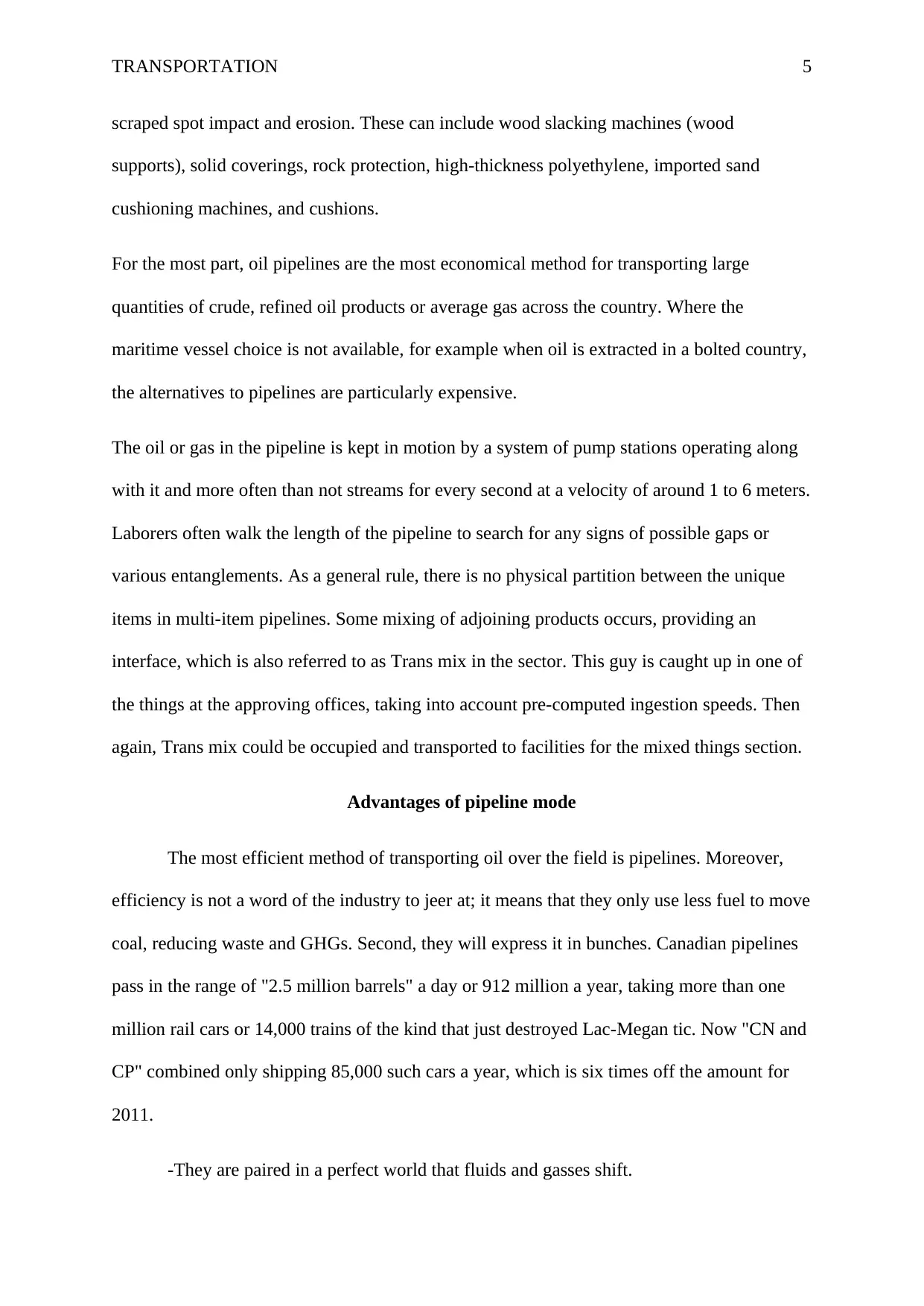
TRANSPORTATION 5
scraped spot impact and erosion. These can include wood slacking machines (wood
supports), solid coverings, rock protection, high-thickness polyethylene, imported sand
cushioning machines, and cushions.
For the most part, oil pipelines are the most economical method for transporting large
quantities of crude, refined oil products or average gas across the country. Where the
maritime vessel choice is not available, for example when oil is extracted in a bolted country,
the alternatives to pipelines are particularly expensive.
The oil or gas in the pipeline is kept in motion by a system of pump stations operating along
with it and more often than not streams for every second at a velocity of around 1 to 6 meters.
Laborers often walk the length of the pipeline to search for any signs of possible gaps or
various entanglements. As a general rule, there is no physical partition between the unique
items in multi-item pipelines. Some mixing of adjoining products occurs, providing an
interface, which is also referred to as Trans mix in the sector. This guy is caught up in one of
the things at the approving offices, taking into account pre-computed ingestion speeds. Then
again, Trans mix could be occupied and transported to facilities for the mixed things section.
Advantages of pipeline mode
The most efficient method of transporting oil over the field is pipelines. Moreover,
efficiency is not a word of the industry to jeer at; it means that they only use less fuel to move
coal, reducing waste and GHGs. Second, they will express it in bunches. Canadian pipelines
pass in the range of "2.5 million barrels" a day or 912 million a year, taking more than one
million rail cars or 14,000 trains of the kind that just destroyed Lac-Megan tic. Now "CN and
CP" combined only shipping 85,000 such cars a year, which is six times off the amount for
2011.
-They are paired in a perfect world that fluids and gasses shift.
scraped spot impact and erosion. These can include wood slacking machines (wood
supports), solid coverings, rock protection, high-thickness polyethylene, imported sand
cushioning machines, and cushions.
For the most part, oil pipelines are the most economical method for transporting large
quantities of crude, refined oil products or average gas across the country. Where the
maritime vessel choice is not available, for example when oil is extracted in a bolted country,
the alternatives to pipelines are particularly expensive.
The oil or gas in the pipeline is kept in motion by a system of pump stations operating along
with it and more often than not streams for every second at a velocity of around 1 to 6 meters.
Laborers often walk the length of the pipeline to search for any signs of possible gaps or
various entanglements. As a general rule, there is no physical partition between the unique
items in multi-item pipelines. Some mixing of adjoining products occurs, providing an
interface, which is also referred to as Trans mix in the sector. This guy is caught up in one of
the things at the approving offices, taking into account pre-computed ingestion speeds. Then
again, Trans mix could be occupied and transported to facilities for the mixed things section.
Advantages of pipeline mode
The most efficient method of transporting oil over the field is pipelines. Moreover,
efficiency is not a word of the industry to jeer at; it means that they only use less fuel to move
coal, reducing waste and GHGs. Second, they will express it in bunches. Canadian pipelines
pass in the range of "2.5 million barrels" a day or 912 million a year, taking more than one
million rail cars or 14,000 trains of the kind that just destroyed Lac-Megan tic. Now "CN and
CP" combined only shipping 85,000 such cars a year, which is six times off the amount for
2011.
-They are paired in a perfect world that fluids and gasses shift.
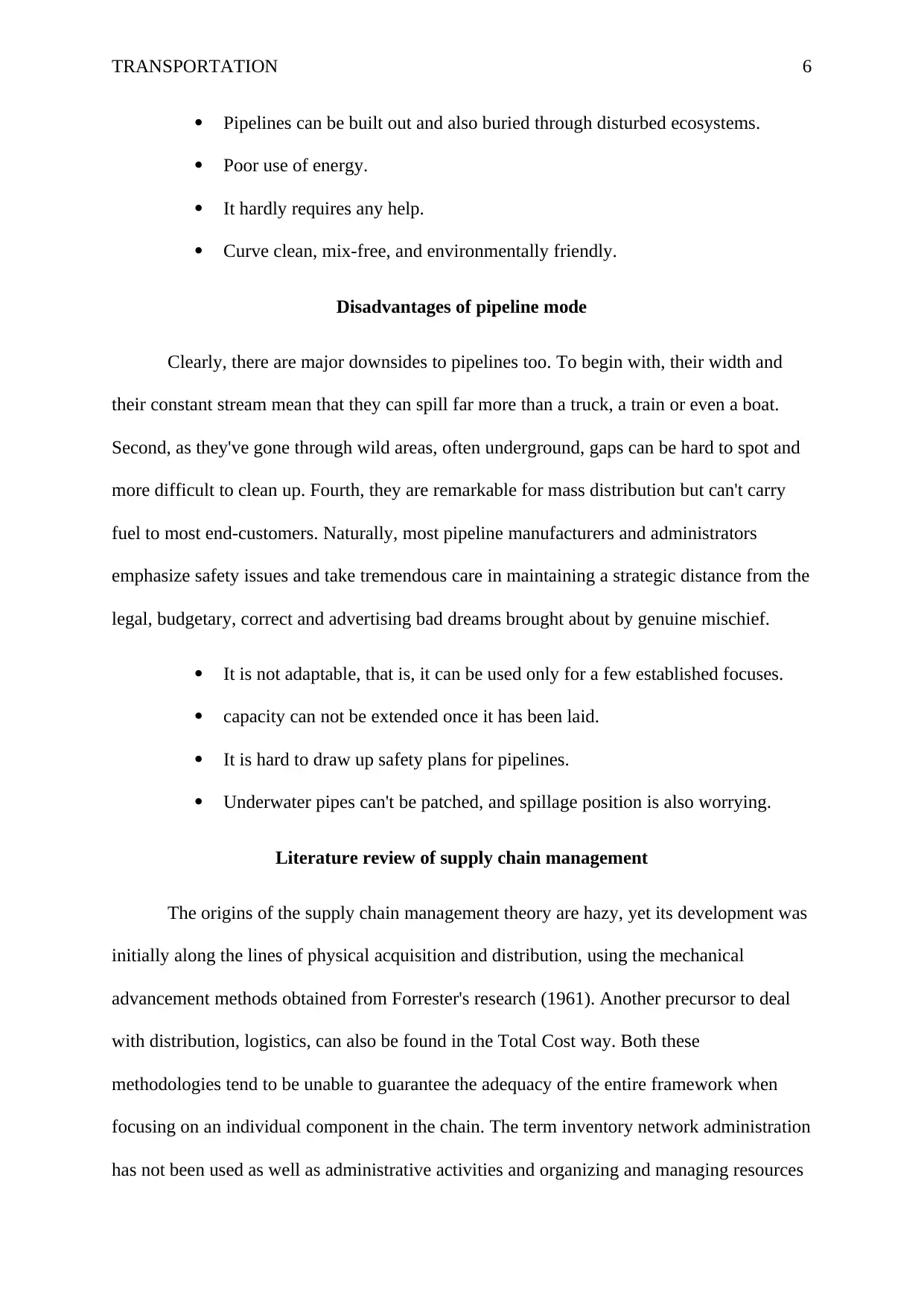
TRANSPORTATION 6
Pipelines can be built out and also buried through disturbed ecosystems.
Poor use of energy.
It hardly requires any help.
Curve clean, mix-free, and environmentally friendly.
Disadvantages of pipeline mode
Clearly, there are major downsides to pipelines too. To begin with, their width and
their constant stream mean that they can spill far more than a truck, a train or even a boat.
Second, as they've gone through wild areas, often underground, gaps can be hard to spot and
more difficult to clean up. Fourth, they are remarkable for mass distribution but can't carry
fuel to most end-customers. Naturally, most pipeline manufacturers and administrators
emphasize safety issues and take tremendous care in maintaining a strategic distance from the
legal, budgetary, correct and advertising bad dreams brought about by genuine mischief.
It is not adaptable, that is, it can be used only for a few established focuses.
capacity can not be extended once it has been laid.
It is hard to draw up safety plans for pipelines.
Underwater pipes can't be patched, and spillage position is also worrying.
Literature review of supply chain management
The origins of the supply chain management theory are hazy, yet its development was
initially along the lines of physical acquisition and distribution, using the mechanical
advancement methods obtained from Forrester's research (1961). Another precursor to deal
with distribution, logistics, can also be found in the Total Cost way. Both these
methodologies tend to be unable to guarantee the adequacy of the entire framework when
focusing on an individual component in the chain. The term inventory network administration
has not been used as well as administrative activities and organizing and managing resources
Pipelines can be built out and also buried through disturbed ecosystems.
Poor use of energy.
It hardly requires any help.
Curve clean, mix-free, and environmentally friendly.
Disadvantages of pipeline mode
Clearly, there are major downsides to pipelines too. To begin with, their width and
their constant stream mean that they can spill far more than a truck, a train or even a boat.
Second, as they've gone through wild areas, often underground, gaps can be hard to spot and
more difficult to clean up. Fourth, they are remarkable for mass distribution but can't carry
fuel to most end-customers. Naturally, most pipeline manufacturers and administrators
emphasize safety issues and take tremendous care in maintaining a strategic distance from the
legal, budgetary, correct and advertising bad dreams brought about by genuine mischief.
It is not adaptable, that is, it can be used only for a few established focuses.
capacity can not be extended once it has been laid.
It is hard to draw up safety plans for pipelines.
Underwater pipes can't be patched, and spillage position is also worrying.
Literature review of supply chain management
The origins of the supply chain management theory are hazy, yet its development was
initially along the lines of physical acquisition and distribution, using the mechanical
advancement methods obtained from Forrester's research (1961). Another precursor to deal
with distribution, logistics, can also be found in the Total Cost way. Both these
methodologies tend to be unable to guarantee the adequacy of the entire framework when
focusing on an individual component in the chain. The term inventory network administration
has not been used as well as administrative activities and organizing and managing resources
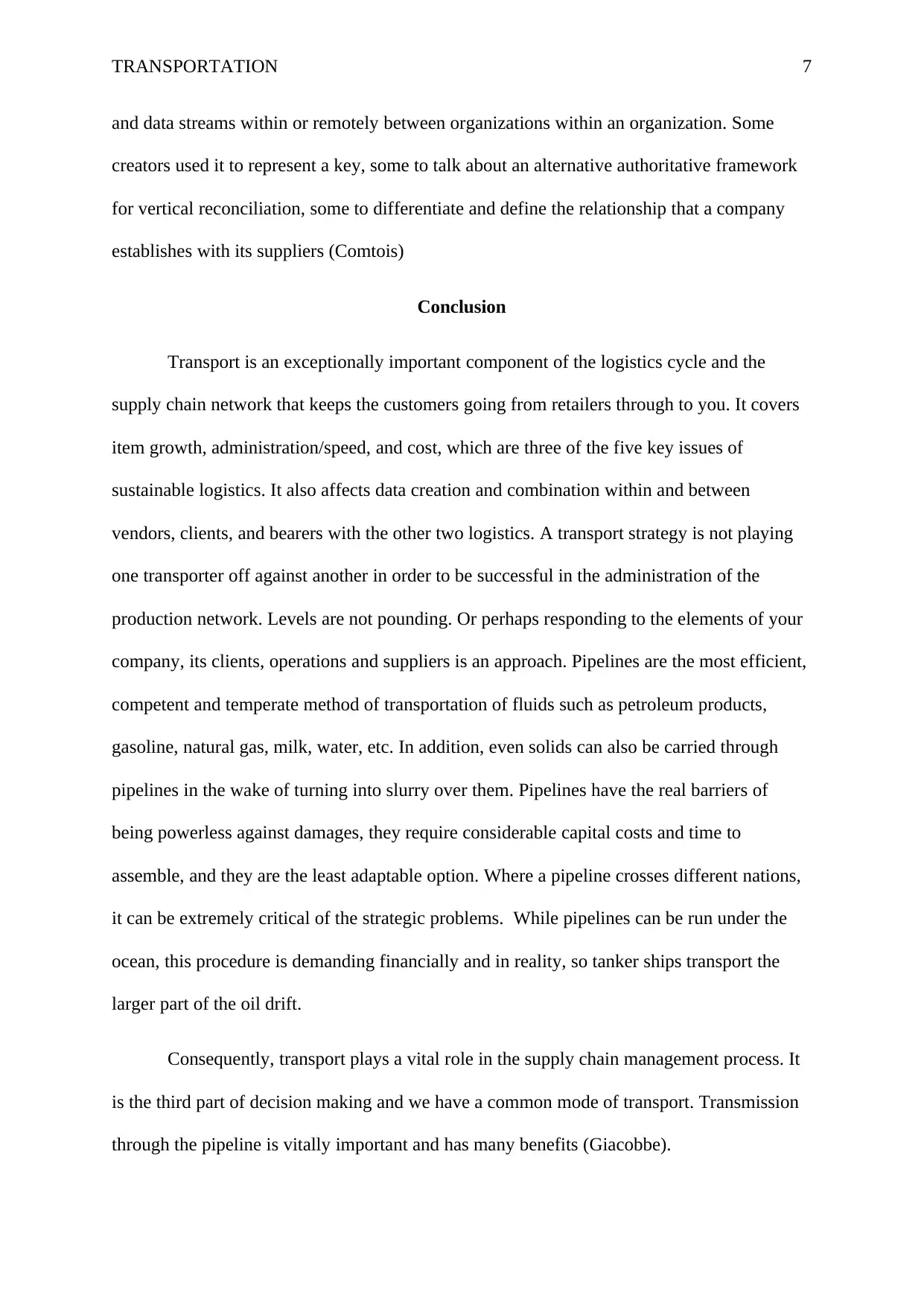
TRANSPORTATION 7
and data streams within or remotely between organizations within an organization. Some
creators used it to represent a key, some to talk about an alternative authoritative framework
for vertical reconciliation, some to differentiate and define the relationship that a company
establishes with its suppliers (Comtois)
Conclusion
Transport is an exceptionally important component of the logistics cycle and the
supply chain network that keeps the customers going from retailers through to you. It covers
item growth, administration/speed, and cost, which are three of the five key issues of
sustainable logistics. It also affects data creation and combination within and between
vendors, clients, and bearers with the other two logistics. A transport strategy is not playing
one transporter off against another in order to be successful in the administration of the
production network. Levels are not pounding. Or perhaps responding to the elements of your
company, its clients, operations and suppliers is an approach. Pipelines are the most efficient,
competent and temperate method of transportation of fluids such as petroleum products,
gasoline, natural gas, milk, water, etc. In addition, even solids can also be carried through
pipelines in the wake of turning into slurry over them. Pipelines have the real barriers of
being powerless against damages, they require considerable capital costs and time to
assemble, and they are the least adaptable option. Where a pipeline crosses different nations,
it can be extremely critical of the strategic problems. While pipelines can be run under the
ocean, this procedure is demanding financially and in reality, so tanker ships transport the
larger part of the oil drift.
Consequently, transport plays a vital role in the supply chain management process. It
is the third part of decision making and we have a common mode of transport. Transmission
through the pipeline is vitally important and has many benefits (Giacobbe).
and data streams within or remotely between organizations within an organization. Some
creators used it to represent a key, some to talk about an alternative authoritative framework
for vertical reconciliation, some to differentiate and define the relationship that a company
establishes with its suppliers (Comtois)
Conclusion
Transport is an exceptionally important component of the logistics cycle and the
supply chain network that keeps the customers going from retailers through to you. It covers
item growth, administration/speed, and cost, which are three of the five key issues of
sustainable logistics. It also affects data creation and combination within and between
vendors, clients, and bearers with the other two logistics. A transport strategy is not playing
one transporter off against another in order to be successful in the administration of the
production network. Levels are not pounding. Or perhaps responding to the elements of your
company, its clients, operations and suppliers is an approach. Pipelines are the most efficient,
competent and temperate method of transportation of fluids such as petroleum products,
gasoline, natural gas, milk, water, etc. In addition, even solids can also be carried through
pipelines in the wake of turning into slurry over them. Pipelines have the real barriers of
being powerless against damages, they require considerable capital costs and time to
assemble, and they are the least adaptable option. Where a pipeline crosses different nations,
it can be extremely critical of the strategic problems. While pipelines can be run under the
ocean, this procedure is demanding financially and in reality, so tanker ships transport the
larger part of the oil drift.
Consequently, transport plays a vital role in the supply chain management process. It
is the third part of decision making and we have a common mode of transport. Transmission
through the pipeline is vitally important and has many benefits (Giacobbe).
Paraphrase This Document
Need a fresh take? Get an instant paraphrase of this document with our AI Paraphraser
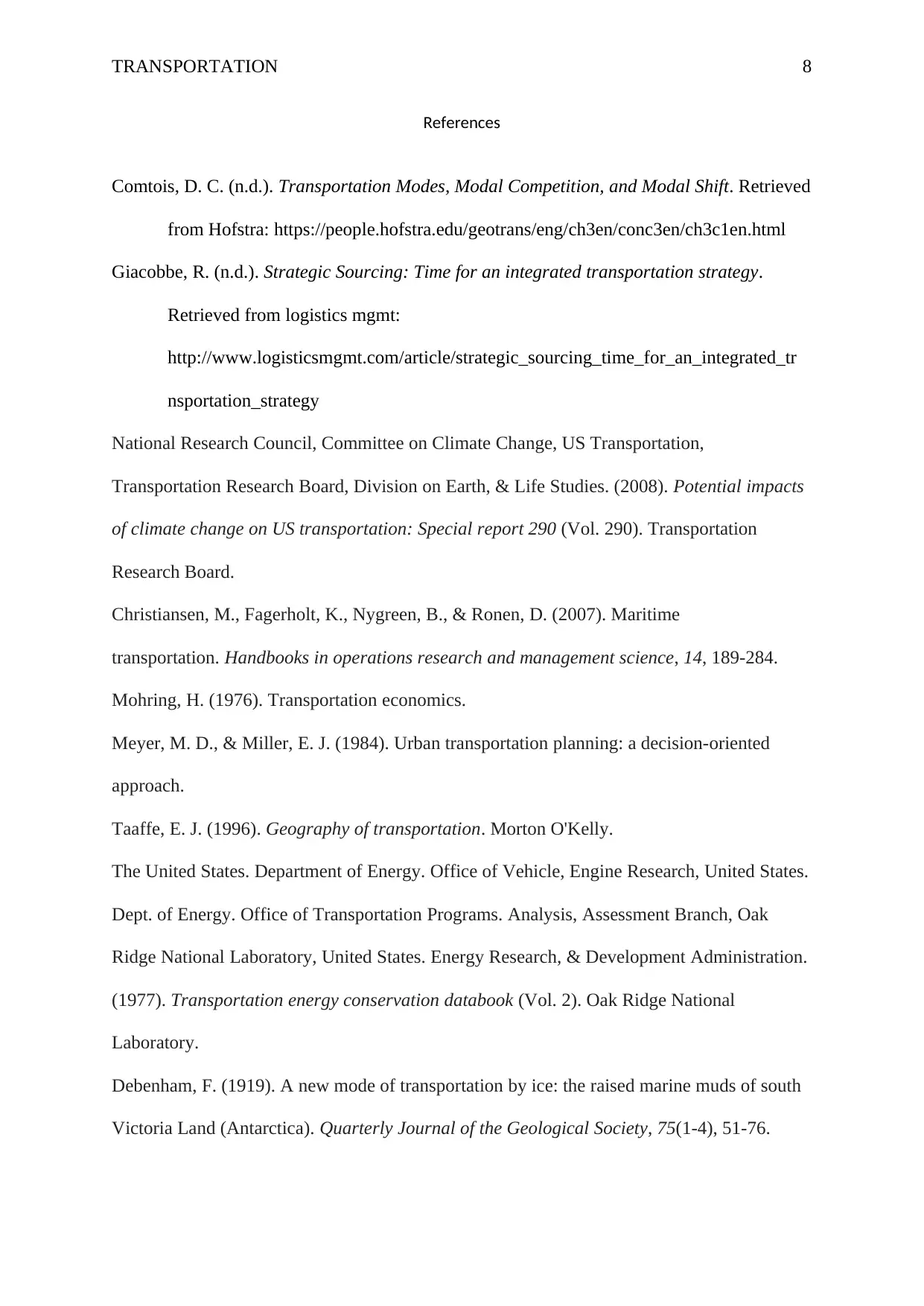
TRANSPORTATION 8
References
Comtois, D. C. (n.d.). Transportation Modes, Modal Competition, and Modal Shift. Retrieved
from Hofstra: https://people.hofstra.edu/geotrans/eng/ch3en/conc3en/ch3c1en.html
Giacobbe, R. (n.d.). Strategic Sourcing: Time for an integrated transportation strategy.
Retrieved from logistics mgmt:
http://www.logisticsmgmt.com/article/strategic_sourcing_time_for_an_integrated_tr
nsportation_strategy
National Research Council, Committee on Climate Change, US Transportation,
Transportation Research Board, Division on Earth, & Life Studies. (2008). Potential impacts
of climate change on US transportation: Special report 290 (Vol. 290). Transportation
Research Board.
Christiansen, M., Fagerholt, K., Nygreen, B., & Ronen, D. (2007). Maritime
transportation. Handbooks in operations research and management science, 14, 189-284.
Mohring, H. (1976). Transportation economics.
Meyer, M. D., & Miller, E. J. (1984). Urban transportation planning: a decision-oriented
approach.
Taaffe, E. J. (1996). Geography of transportation. Morton O'Kelly.
The United States. Department of Energy. Office of Vehicle, Engine Research, United States.
Dept. of Energy. Office of Transportation Programs. Analysis, Assessment Branch, Oak
Ridge National Laboratory, United States. Energy Research, & Development Administration.
(1977). Transportation energy conservation databook (Vol. 2). Oak Ridge National
Laboratory.
Debenham, F. (1919). A new mode of transportation by ice: the raised marine muds of south
Victoria Land (Antarctica). Quarterly Journal of the Geological Society, 75(1-4), 51-76.
References
Comtois, D. C. (n.d.). Transportation Modes, Modal Competition, and Modal Shift. Retrieved
from Hofstra: https://people.hofstra.edu/geotrans/eng/ch3en/conc3en/ch3c1en.html
Giacobbe, R. (n.d.). Strategic Sourcing: Time for an integrated transportation strategy.
Retrieved from logistics mgmt:
http://www.logisticsmgmt.com/article/strategic_sourcing_time_for_an_integrated_tr
nsportation_strategy
National Research Council, Committee on Climate Change, US Transportation,
Transportation Research Board, Division on Earth, & Life Studies. (2008). Potential impacts
of climate change on US transportation: Special report 290 (Vol. 290). Transportation
Research Board.
Christiansen, M., Fagerholt, K., Nygreen, B., & Ronen, D. (2007). Maritime
transportation. Handbooks in operations research and management science, 14, 189-284.
Mohring, H. (1976). Transportation economics.
Meyer, M. D., & Miller, E. J. (1984). Urban transportation planning: a decision-oriented
approach.
Taaffe, E. J. (1996). Geography of transportation. Morton O'Kelly.
The United States. Department of Energy. Office of Vehicle, Engine Research, United States.
Dept. of Energy. Office of Transportation Programs. Analysis, Assessment Branch, Oak
Ridge National Laboratory, United States. Energy Research, & Development Administration.
(1977). Transportation energy conservation databook (Vol. 2). Oak Ridge National
Laboratory.
Debenham, F. (1919). A new mode of transportation by ice: the raised marine muds of south
Victoria Land (Antarctica). Quarterly Journal of the Geological Society, 75(1-4), 51-76.
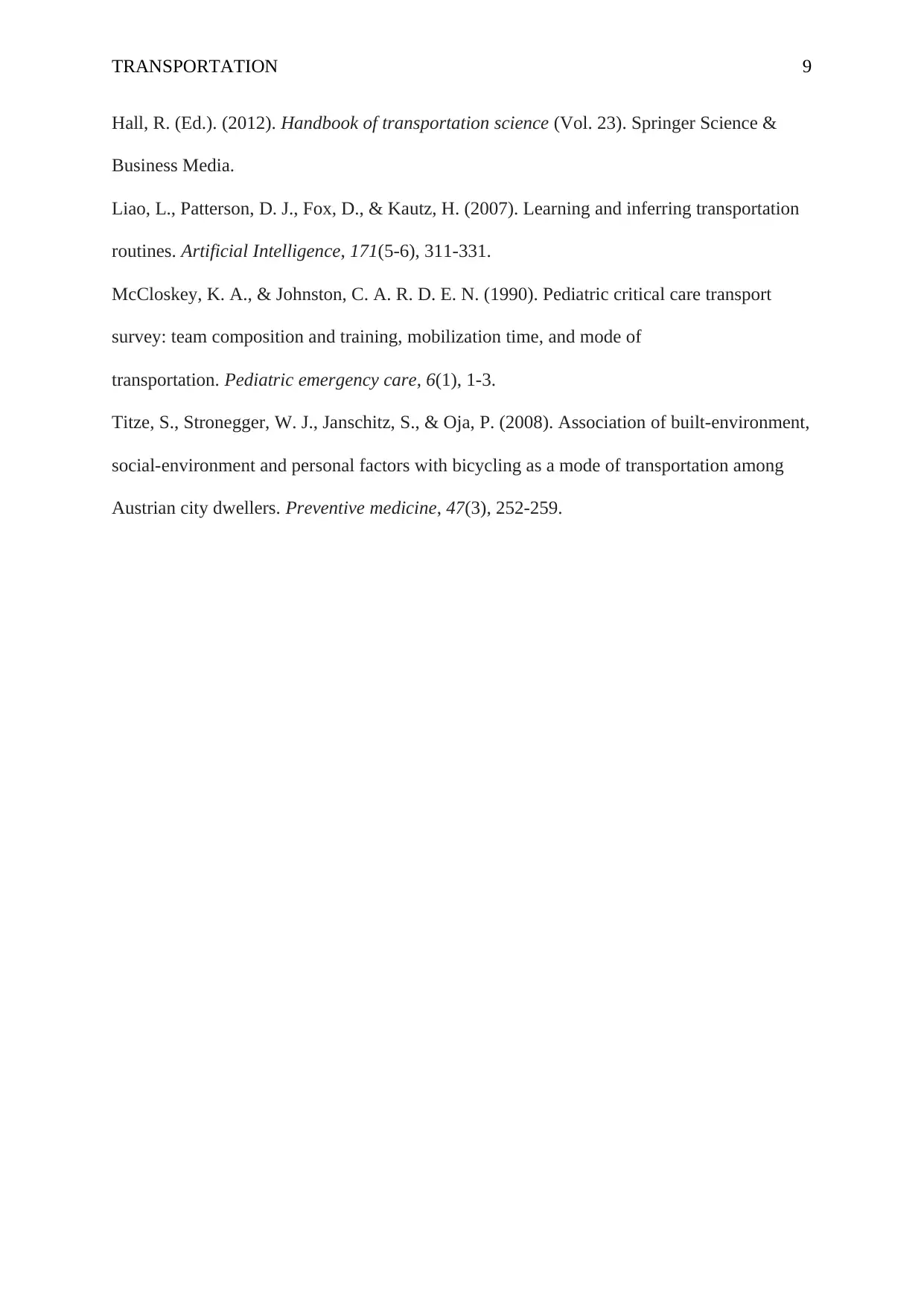
TRANSPORTATION 9
Hall, R. (Ed.). (2012). Handbook of transportation science (Vol. 23). Springer Science &
Business Media.
Liao, L., Patterson, D. J., Fox, D., & Kautz, H. (2007). Learning and inferring transportation
routines. Artificial Intelligence, 171(5-6), 311-331.
McCloskey, K. A., & Johnston, C. A. R. D. E. N. (1990). Pediatric critical care transport
survey: team composition and training, mobilization time, and mode of
transportation. Pediatric emergency care, 6(1), 1-3.
Titze, S., Stronegger, W. J., Janschitz, S., & Oja, P. (2008). Association of built-environment,
social-environment and personal factors with bicycling as a mode of transportation among
Austrian city dwellers. Preventive medicine, 47(3), 252-259.
Hall, R. (Ed.). (2012). Handbook of transportation science (Vol. 23). Springer Science &
Business Media.
Liao, L., Patterson, D. J., Fox, D., & Kautz, H. (2007). Learning and inferring transportation
routines. Artificial Intelligence, 171(5-6), 311-331.
McCloskey, K. A., & Johnston, C. A. R. D. E. N. (1990). Pediatric critical care transport
survey: team composition and training, mobilization time, and mode of
transportation. Pediatric emergency care, 6(1), 1-3.
Titze, S., Stronegger, W. J., Janschitz, S., & Oja, P. (2008). Association of built-environment,
social-environment and personal factors with bicycling as a mode of transportation among
Austrian city dwellers. Preventive medicine, 47(3), 252-259.
1 out of 9
Related Documents
Your All-in-One AI-Powered Toolkit for Academic Success.
+13062052269
info@desklib.com
Available 24*7 on WhatsApp / Email
![[object Object]](/_next/static/media/star-bottom.7253800d.svg)
Unlock your academic potential
© 2024 | Zucol Services PVT LTD | All rights reserved.





